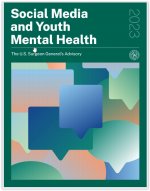
Social Media and Youth Mental Health: The U.S. Surgeon General’s Advisory
Omschrijving
Social media1 use by youth is nearly universal. Up to 95% of youth ages 13–17 report using a social media platform, with more than a third saying they use social media “almost constantly.” 2 Although age 13 is commonly the required minimum age used by social media platforms in the U.S.,3 nearly 40% of children ages 8–12 use social media.4 Despite this widespread use among children and adolescents, robust independent safety analyses on the impact of social media on youth have not yet been conducted. There are increasing concerns among researchers, parents and caregivers, young people, healthcare experts, and others about the impact of social media on youth mental health.5, 6
More research is needed to fully understand the impact of social media; however, the current body of evidence indicates that while social media may have benefits for some children and adolescents, there are ample indicators that social media can also have a profound risk of harm to the mental health and well-being of children and adolescents. At this time, we do not yet have enough evidence to determine if social media is sufficiently safe for children and adolescents. We must acknowledge the growing body of research about potential harms, increase our collective understanding of the risks associated
with social media use, and urgently take action to create safe and healthy digital environments that minimize harm and safeguard children’s and adolescents’ mental health and well-being during critical stages of development.
We Must Take Action: A Way Forward
Our children and adolescents don’t have the luxury of waiting years until we know the full extent of social media’s impact. Their childhoods and development are happening now. While social media use can have positive impacts for some children, the evidence noted throughout this Surgeon General’s Advisory necessitates significant concern with the way it is currently designed, deployed, and utilized. Child and adolescent use of platforms designed for adults places them at high risk of “unsupervised, developmentally inappropriate, and potentially harmful” use according to the National Scientific Council on Adolescence.87 At a moment when we are experiencing a national youth mental health crisis, now is the time to act swiftly and decisively to protect children and adolescents from risk of harm.
To date, the burden of protecting youth has fallen predominantly on children, adolescents, and their families. Parents face significant challenges in managing children and adolescents’ use of social media applications, and youth are using social media at increasingly earlier ages.4, 88 Nearly 70% of parents say parenting is now more difficult than it was 20 years ago, with technology and social media as the top two cited reasons.89 While nearly all parents believe they have a responsibility to protect their children from inappropriate content online,89 the entire burden of mitigating the risk of harm of social media cannot be placed on the shoulders of children and parents. Nearly 80% of parents believe technology companies have a responsibility to protect children from inappropriate content as well.89
We must provide children and their families with the information and tools to navigate the changing digital environment, but this burden to support our children must be further shared. There are actions technology companies can take to make their platforms safer for children and adolescents. There are actions researchers can take to develop the necessary research base to support further safeguards. And there is a role for local, state, and federal policy to implement protections for our children and adolescents.
